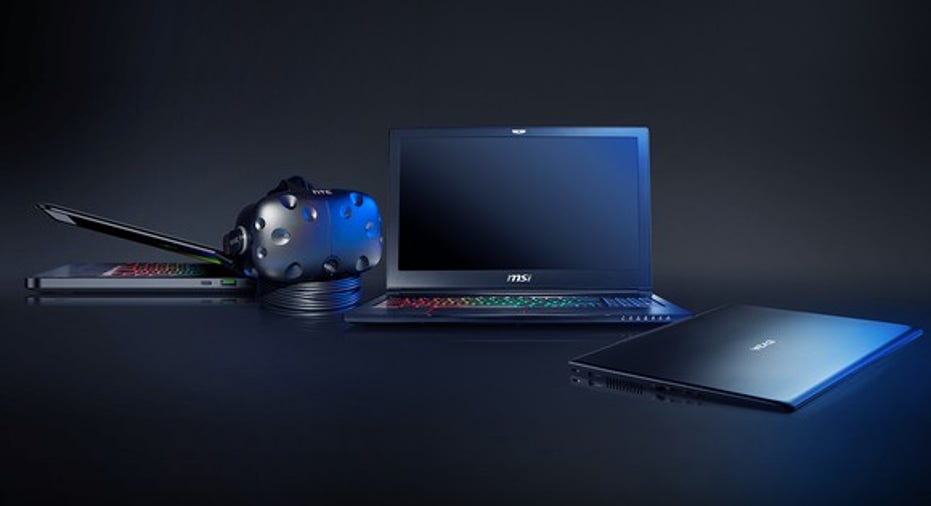Here's How NVIDIA Is Preparing for the Next Generation of Gaming

Image source: NVIDIA.
This week,NVIIDA (NASDAQ: NVDA) debuted three new laptop graphics cards. That's usually not big news, but this time around it was because the company's new GeForce GTX 1080, 1070, and 1060 are within a stone's throw of the graphics-processing specs of its desktop graphics cards.The company says the laptop cards' performance comes within 10% of their desktop equivalents, and all receive the VR-ready (virtual reality) designation.
Typically, there's a pretty big difference between how well a desktop handles gaming graphics compared to a laptop. The laptops, of course, don't have as much space, cooling power, or battery life to keep up. But NVIDIA's new GPUs aim to at least give portable PCs a very comparable gaming experience.
The company believes so much in the new GPUs that it dropped the usual "M" designation that used to come after its laptop graphics-card names, indicating that they were only for mobile PCs.
The cards are a huge step forward for both laptop gaming and for NVIDIA. And it should help keep the company ahead of its graphics-card rival, Advanced Micro Devices (NASDAQ: AMD).
How the new cards give NVIDIA an edge
All of the new NVIDIA cards are based on the company's new Pascal architecture,and NVIDIA says they are the "ideal foundation for building notebook platforms that enable virtual reality to be experienced on the go."That plays into the company's increasingfocus on virtual reality.VR is a small, but quickly growing, segment of gaming, and NVIDIA is helping to usher it in by boosting its laptop-based GPUs.
Near-desktop-level graphics processing on laptops could help encourage VR hardware and software sales. (Right now, just 1% of PCs are capable of running high-end VR systems.) This encourages more OEMs to build VR-ready computers.The VR market will be worth an estimated $70 billion by 2020, and NVIDIA is looking to grab a big slice of thatpie by selling GPUs to computer makers.
The second part to all this is NVIDIA's acknowledgement -- by dropping the M from the graphics-card names -- that laptops shouldn't be a substandard gaming experience.Sales of portable PCs continue to outpace desktop sales, and there's no indication that will change.
Consumers will increasingly expect their laptop graphics processing to catch up to the performance of their desktops as that trend continues.Both NVIDIA and AMD know this and are building GPUs that are both more powerful and efficient.
AMD recently released its Polaris architecture in order to squeeze more power efficiency out of the company's GPUs. Polaris is the company's answer to NVIDIA's Pascal architecture, and its attempt to catch up to NVIDIA's dominant position.
NVIDIA's holding its ground
NVIDIA makes the vast majority of its revenuefrom gaming -- 50% in Q2 2017-- so the new GXT graphics cards are a pretty important piece to the company's revenue puzzle.But AMD is making some gains in the GPU gaming space. The company closed the gap between itself and NVIDIA earlier this year by grabbing 38.7% of the notebook discrete graphics market, leaving NVIDIA with the rest of the market.
NVIDIA's new graphics cards aren't just a bet on portable PC gaming and VR. They're also a way to help ensure that the company continues to outpace any AMD advancements.
A secret billion-dollar stock opportunity The world's biggest tech company forgot to show you something, but a few Wall Street analysts and the Fool didn't miss a beat: There's a small company that's powering their brand-new gadgets and the coming revolution in technology. And we think its stock price has nearly unlimited room to run for early in-the-know investors! To be one of them, just click here.
Chris Neiger has no position in any stocks mentioned. The Motley Fool owns shares of and recommends Nvidia. Try any of our Foolish newsletter services free for 30 days. We Fools may not all hold the same opinions, but we all believe that considering a diverse range of insights makes us better investors. The Motley Fool has a disclosure policy.